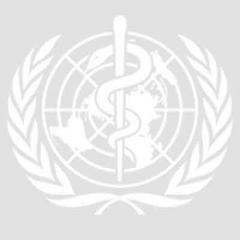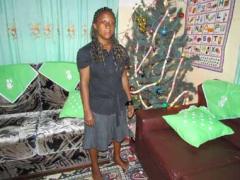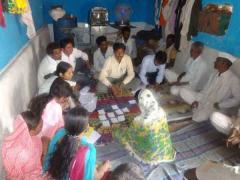Your progress
0%
The activities below can help you address the needs of people with disabilities affected by leprosy.

The CBR strategy is applicable to all people experiencing disability, and many of the suggested activities in these guidelines also apply to people affected by leprosy. Therefore, this section should be read alongside the other major components of the CBR matrix – health, education, livelihood, social and empowerment. In addition, publications such as the WHO/ILEP technical guide on community-based rehabilitation and leprosy provide a detailed overview of suggested activities for CBR.
Use your mouse or keyboard to expand each of the activity headings below. To add an activity to your action plan, select the Add button beside it. Once you have added an activity to your action plan, select Action plan >My action plan from the menu above to complete that activity.
CBR needs to work across all sectors to ensure that people affected by leprosy can access mainstream development programmes and activities. As women with leprosy-related impairments are even more vulnerable to exclusion and poverty, CBR needs to take extra precautions to make sure that they also have the opportunity to participate in and benefit from CBR activities.
Health
People experiencing impairments related to leprosy will require health interventions to
CBR can support appropriate health-related interventions by:

Education
Children may be directly affected by leprosy, or may suffer because their parents or relatives are affected by leprosy. As a result, they may be denied access to school, forced to drop out, isolated from former friends, hidden away by their families, or required to work and earn an income.
Livelihood
People with leprosy are often very poor. Stigma, discrimination and disability associated with leprosy often restrict opportunities for work, which increases their poverty. Skills training and decent work can provide a strong entry pointfor integration into society, and are a mechanism for breaking the cycle of isolation,dependency and poverty commonly associated with disability. When people with disabilities are able to make financial contributions to their families, they often report increased participation in family activities such as decision-making.
Learn about how a man affected with leprosy overcame stigma and made a living to support his family.


Mohammed Ali Ashraf’s story shows how CBR and poverty reduction work is sustainable and can bring long-term benefits.
Mohammed lives in a tiny hamlet of houses amongst paddy fields called Candikona in Bogra district. He was diagnosed with leprosy in 2003 and had completed his treatment by 2004 but was left with permanent drop foot. He had to stop earning money as a rickshaw puller as he was unable to feel and grip his bicycle peddles. He lost almost everything and had to sell his animals, his land, and materials such as corrugated sheeting that formed part of his home just to earn some money for his family. In 2006 he became part of a Lepra CBR organization. He received training in growing trees and in tree grafting. He then received a loan of around £100 which he used to repair his house and to buy his small plot of land plus materials to start his own plant nursery.
Today, Mohammed has a plant nursery on a small but well-organized plot of land. He grows mango, orange and apple saplings, strawberry plants and other small houseplants. He has become an expert on tree grafting, and grafts mango trees to with high yield fruiting branches onto native saplings that grow best in the local conditions. In addition, he works as an expert in tree grafting locally and uses his skills to teach others. He supplies plants and trees to 7 local plant centres and nurseries.
Over the last 6 years he has invested back into his business and grown his nursery into a profitable business. He now earns more than he did as a rickshaw puller and has a greater pride in his work and skills. He once felt that his largest financial worry was raising the money for each of his daughter’s dowries. He has four daughters, each requiring a huge dowry of around £400 – almost an entire annual household income in his locality. This massive expense is one than he can now afford more easily without getting himself into debt, which means that he has secured the futures of his daughters. His increased economic status, local social status as a skilled expert in fruit tree growing, as well as his positive attitude have beaten any stigma he experienced due to leprosy and allowed him to find husbands for his daughters.
Footnote:
This story was retrieved and edited from Lepra.

Social
Stigma, discrimination and misconceptions about leprosy often result in people being unable to access mainstream services and participate in the life of their communities.CBR personnel can play a very important role in reducing stigmatizing attitudes and practices in the community by:
Empowerment
It is important that people affected by leprosy are aware of their rights and how to speak up for themselves so that they can gain access to services and resources. Self-organization can be an effective way to do this, and around the world, people affected by leprosy have organized themselves into local groups and associations. Some people have also joined local disabled people’s organizations. These associations have been active in organizing empowerment workshops and other meetings on themes, such as the International Convention on Rights of Persons with Disabilities. CBR can support people affected by leprosy in accessing self-help groups and DPOs in their local areas.
Learn about how a woman affected by leprosy was empowered to fight stigma towards leprosy.


Felista Manyasi was born in 1989 at Muganza village, Chato district, Kagera region, Tanzania. In 2004, she contracted leprosy at the age of 15. Felista was regarded by her parents as an outcast and denied medical services, due to worries associated with witchcraft beliefs.
Felista was not able to access treatment immediately, and started developing a drop foot, claw hands and a drop mouth. She was then rejected by her parents and later was picked up by Dr. Mwandu, a leprosy surgeon at Kolandoto Hospital at the time, while on his outreach visits.
Felista was well taken care of at Kolandoto hospital. She was put on leprosy treatment and had surgical operations to correct her clap foot and claw hands. After she received treatment, the German Leprosy and TB Relief Association (GLRA), Regional TB & local Leprosy coordinator helped her to attend the secondary school. While at this school, she was selected to join the government secondary school. There, she faced another blow as the headmistress rejected her on account of leprosy. The issue was reported to higher authorities in the Ministry of education, and they directed the school headmistress to accept Felista at school.
Felista’s four years at school were very lonely because most of her fellow students isolated her because they were worried about contracting leprosy. Felista bravely endured the situation and finished her secondary school education successfully in 2008. A year later she was accepted at Kolandoto Medical Laboratory School to study to become a Laboratory Technician, and GLRA guaranteed to sponsor her for the duration of the course. She passed her first year’s examination with flying colors and was admitted in the second year.
Today, Felista is the first person affected by leprosy to join the medical profession in Tanzania. Her ambition is to work at health facilities whose major clients are people affected by leprosy. She would like to be involved in ensuring that the people affected by leprosy can access medical services like other individuals and to mobilize people affected by leprosy in fighting the stigma towards the leprosy disease.
Footnote:
This story was retrieved and edited from Deutsche Lepra und Tuberkulosehilfe (DAHW).
CBR should encourage leprosy rehabilitation programmes to make their services available to other people with disabilities. This could have many benefits. It can help to reduce the stigma associated with leprosy, facilitate the integration of leprosy services into mainstream sectors and ensure that more people are able to benefit from existing services.
In areas where only specialized leprosy programmes and services exist, they should be encouraged to introduce the CBR strategy as a way of opening up their services to people with other disabilities. When networking with these programmes, it is essential to share information, reduce duplication of services and explore new ways to respond to rehabilitation needs.
CBR should be particularly focused on building the capacity of all stakeholders to enable them to move towards an inclusive CBR approach. Stakeholders may include CBR personnel, personnel from leprosy programmes and services, people affected by leprosy, people with disabilities, family members and disabled people’s organizations. Suggested activities include the following:
Learn about how one man affected with leprosy became an inspiration to many.


Suresh Dhongde is a project manager on a CBM-funded project in India, but more importantly he is a mascot of successful leprosy treatment. Here is how he is encouraging people with disabilities.
“Motivating others is my mission”
Suresh Dhongde’s success shows how access to education and good healthcare can change somebody’s life. Today, the 35-year-old is a proud recipient of the national award for being a role model in overcoming leprosy. Not only is he an inspiration to many, Suresh is also helping persons with disabilities realize their maximum potential. “I don’t want anybody to experience helplessness because of their physical condition. The real potential resides in the brain, not in the body,” he asserts.
Lost Hope
Suresh was born in Bhalegaon village of Buldhana district in Maharashtra (India), and started getting numb skin patches when he was just 16. He consulted his local doctor who was unable to discover the reason for his condition and the patches that kept spreading on his body. Eventually, a doctor in the district town 70 km away diagnosed leprosy and recommended a two year course of medicine. However, the difficulty of traveling long distances and financial constraints meant there were frequent gaps in Suresh’s medication. In October 1998, the growing infection caused extreme pain throughout his body. He was rushed to the leprosy hospital in Pune where the doctors gave no hope of survival.
However, Suresh’s will to live and good medical care helped see him through. The hospital mandated work for residents in exchange for their stay. Soon, Suresh was administering medicines and injections to other patients and in he time became the ward in-charge.
Education to the rescue
Despite the improvement in his physical condition, Suresh was not yet sure about his future as an uneducated leprosy patient in the outside world. “There’s a lot of stigma attached to leprosy. I decided not to go back to my village as I could not imagine a good future there,” he says. In 2001, Suresh experienced a turn of events when he was sent for a six-month computer course at an institute run by the Leprosy Mission Trust at Nashik. What really changed his attitude was the example he saw of several other leprosy patients getting an education.
With financial help from the Leprosy Mission, Suresh started attending Class XII at a nearby college on Saturdays. His hard work paid off and he passed with first division. The Leprosy Mission kept supporting his studies and Suresh went on to do an MBA, MA in Political Science, and then a Masters in Social Work.
Expanding Horizons
Suresh is currently working as a project manager on a CBM-funded project for community-based rehabilitation of persons with disabilities in the Melghat region of Maharashtra, India. The project has reached out to 590 people with disabilities in 60 villages of Melghat since 2011 with the aim of holistic development through focus on health, education, livelihood, social inclusion and empowerment. Through the efforts of Suresh’s team, 500 of the 590 people with disabilities in the project area have received medical certificates, which are essential to avail government schemes and benefits.
The project’s cornerstones have been to raise awareness to prevent disabilities, medical interventions, assistive devices, admission in schools, vocational training, self-employment loans, political participation and formation of self-help groups. “Instead of Viklang Jan Sanghtans which are exclusive to people with disabilities, we have formed Jan Vikas Sanghtans which allow memberships to non-disabled as well. This is to encourage greater participation of people with disabilities in the mainstream,” Suresh explains.
The project also helped in his personal growth as his horizon expanded from leprosy to the 10 disabilities CBM addresses. “I now know that the arena of disability extends beyond leprosy. Special trainings on participatory approaches, human rights and gender have also improved my understanding of social issues,” he says.
Along with his daily work, Suresh is pursuing a Ph.D in social work and a diploma in mechanical engineering. His life makes you realize truth of the words: “Adversity brings out the best in us.”
Footnote:
This story was retrieved and edited from http://www.cbm.org/-Adversity-brings-out-the-best-in-us–453116.php#